This site uses only a few technical cookies necessary for its operation. By continuing to browse, you accept their use.
To find out more...
To find out more...
Circles vs. moulds tins
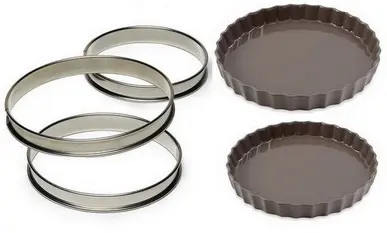
If you like to bake or make quiches, pies etc. you must surely have one or more pie pans at home, in different diameters and perhaps materials.
They are indispensable, without them there is no way to make beautiful pies, and they work very well, but you have another option, instead of moulds, that is pie rings.
They are indispensable, without them there is no way to make beautiful pies, and they work very well, but you have another option, instead of moulds, that is pie rings.
16 K 5/5 (15 reviews)
Keywords for this post:PiesTartsCircleMouldsTipsLast modified on: October 2nd 2020
Circles vs. moulds tins
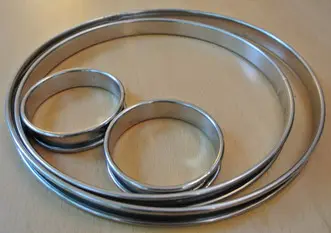
As their name indicates, the circles are simple circles, made of stainless steel, which exist in different diameters, but unlike a mould, a circle has no bottom (yes, this is not an extraordinary statement) so it must be placed on a baking sheet, protected by a sheet of baking paper, or silicone (silpat), before baking.
Before continuing, just 2 words of baker's vocabulary :
-"rolled-out pastry": Piece of dough that is rolled out and used to line a mould/circle
-"line (with pastry)": Action of lining a mould/circle with an abaisse
So on one side we have the classic pie tin, which you put in the oven directly or on a baking sheet, and on the other side the circle, which must be placed on a baking sheet.
Which is better?
The circle has many advantages:- The baking is better, more regular and faster because of the absence of a bottom, more direct contact of the pastry with the heat
- Unmoulding is very easy, you just have to remove the circle from the top and then slide the tart into its serving dish (breaking a tart when taking it out of its mould is a very very frustrating moment!)
- It is very easy to clean, dishwasher safe
- If you go for it carefully, you'll get very elegant and professional right-angled pie edges
- It costs less than a mould
As you can see, it's almost all advantages, that's why pro pastry chefs all use circles, and you can do the same at home.
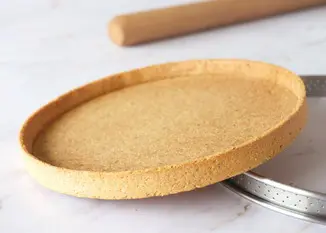
There is only one case, where the mould is preferable, and that is if you are making a quiche, or a tart with a lot of cooking juice, like a tomato tart, or a fresh plum or blackberry tart for example, in these cases having a mould (rather than a circle) that will retain the cooking juice even if you have a leak in your pastry case is very appreciable.
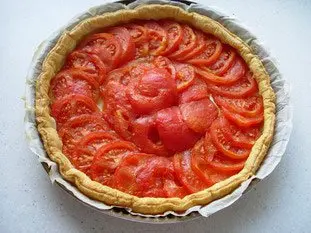
I didn't go into detail, but as for the moulds, there are circles for tarts, of all sizes in fact, and square or rectangular shapes, the pastry cooks speak then rather of "frames".
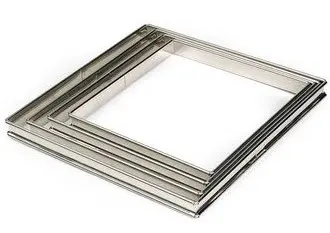
Another quite recent option, the circles are said to be micro-perforated, i.e. pierced with hundreds of small holes that improve the baking process by distributing the heat better.

As always for the material, do not hesitate to put the price, it is an investment on the duration, and to go to provide you in the stores for professionals rather than in the ray kitchen of the great surfaces.
To sum up: Try the circles instead of the pie tins, once you get the hang of it, you will appreciate the difference.
Lasts posts
Butter vs. grease
We often read in a recipe where a pastry is put into a mould that, just before pouring, the mould should be buttered or greased. But what's the difference between these 2 terms?December 1st 20256905
Getting out of the fridge early
Very often when you're cooking, you need to take food or preparations out of the fridge, to use them in the recipe in progress. There's nothing tricky about this: you just take them out of the fridge and use them, usually immediately, in the recipe. But is this really a good method?November 24th 20259725
Who's making the croissants?
When you look at a bakery from the outside, you naturally think that in the bakery, the bakers make the bread, and in the laboratory, the pastry chefs make the cakes. It's very often like that, with each of these professions having quite different ways of working, but sometimes there's also one...November 23th 2025872
Oven height
When we put a dish or cake in the oven, we naturally tend to put it on the middle shelf, and that's what we usually do. But in some cases, this position and height can be a little tricky, so let's find out why.October 8th 20252,4795
The importance of sieving
In recipes that use a fine powder (flour, powdered sugar, etc.), you'll often see the advice to sift before using it. To sift is to pass the powder in question through a sieve (a very fine strainer) before incorporating it into your recipe. It's often advice, but is it really useful?September 3rd 20257,3533
Other pages you may also like
Candied fruits: don't get ripped off
Do you like candied fruit? You might like to nibble a handful or add it to a recipe, like a classic fruit cake or delicious Italian specialities like panettone or sicilian epiphany pie.June 21th 201767 K 24.2
The window-pane test in bread-making
The home bread-makers often ask themselves “Have I kneaded my dough long enough?” . A good question, as dough that is insufficiently kneaded will not rise properly or will fall flat when the top is slashed, which is very frustrating. To know when the dough is ready, one can rely on the length...June 16th 202196 K 23.9
Making the most of seeds: Dry roasting
In cooking, and particularly in baking, there are a lot of seeds we can use, such as linseed, sesame, poppy, etc. Usually, recipes simply say to add them just as they are to the mixture or dough. To make a seeded loaf, for example, prepare a plain bread dough as usual, then, towards the end of...January 30th 201562 K4.0
The golden-brown finish on puff pastry
Let's take a look at the tricky matter of producing puff pastry with an attractive, golden-brown finish. French pastry chefs call this "dorure" (literally, "gilding"). Behind this quirky term there lurks a real problem (and the solution): when using puff pastry (pâte feuilletée) for a pie, or...February 8th 201847 K 24.6
The right weight of pastry for a pie
Let's try to solve a thorny problem: How much dough will I need when I make my next pie? You're planning to make a pie, you're going to use your favourite mould or circle, but how much pastry will you need to fill it completely with a well spread pastry, without being too thin, or on the contrary...March 20th 202066 K4.3
Post a comment or question
Follow this page
If you are interested in this page, you can "follow" it, by entering your email address here. You will then receive a notification immediately each time the page is modified or a new comment is added. Please note that you will need to confirm this following.
Note: We'll never share your e-mail address with anyone else.
Alternatively: you can subscribe to the mailing list of cooling-ez.com , you will receive a e-mail for each new recipe published on the site.









